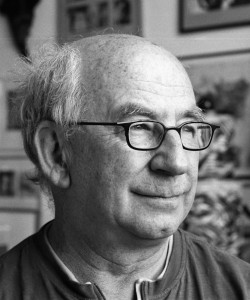(updated on February 20th 2021)
Pierre Hébert, recipient of the Albert-Tessier Quebec government award for cinema in 2004, of the Cinema Career Grant of the Art Council of Quebec in 21012 and, in 2019, of a honorary doctorate by the Emily Carr University of Art and Design, has been pursuing for 50 years his career as filmmaker, performer and visual artist. Self taugh, strongly influenced by animation film makers Norman McLaren and Len Lye, he directed his first films independently while he was still studying Anthropology at the University of Montreal. He worked at The National Film Board of Canada from 1965 until the end of 1999. Since then he continued his career as an independant artist and filmmaker. From 1996 to 1999, he was producer and director of the Animation/Youth studio of the French program of the NFB.
He was first known for his abstract experimental films dealing with perception phenomena ( Op hop, Opus 3, Around perception,Fundamentals of genetics ). Later, although he always kept an experimental approach, his films became more socially and politically involved (Entre chiens et loup, Memories of war). Later, his work grew out of interdisciplinary projects ( Etienne et sara, Songs and dances of the inanimate world – the subway, O Picasso-tableaux d’une surexposition, Adieu bipèdes, La Lettre d’amour ). From 1983, he started to take part in live performances with musicians (Jean Derome, Robert M. Lepage and René Lussier, Fred Frith and Bob Ostertag) and choreographers (Ginette Laurin, Rosalind Newman, Louise Bédard and Jean-Marc Matos) and most of his films of that period evolved from this multidisciplinary practice. He is now working on the «Places and Monuments» project in which he reassess his long time interest in a documentary approach and, by extension, in the relationship between animation and live action shooting. His recent works includes two video installations: Berlin – The Passage of Time, Places and Monuments-6, 2014 (of which there is also a web version) and Cycling Utrecht, Places and Monuments-7, 2015 and two feature length films (Bazin’s film, Mount Fuji seen from a moving train).
Right from his first films, in 1962, Pierre Hébert has been experimenting with the animation technique of engraving images directly on 16mm or 35mm processed black film. In the eighties, he has developped a new type of performance involving “live” animation scratched directly on a film loop while it is rolling in a projector, usually associated with improvised music and occasionnally with dance. He was invited to perform in several New Music or Jazz festivals around the world. In the early 2000, he has expanded this live animation practice with the use of computers in the Living Cinema project along with composer Bob Ostertag. Later, he developped other performance projects involving several other musicians (Only the hand…, 40 Flies, Tropisms). Since 1917, along with his digital performances, he has resumed live scratched animation performances.
Since 2009, he has been pursuing a production of drawings. Some (the series Tropisms and Inner Shields) have been exhibited at the ExCentris Cinema in Montreal, at Le Cercle in Quebec City and at the Musée-chateau de l’agglomération d’Annecy, in France, that has acquired several of the drawings for its permanent collection. In August 2014, he started the project Heads, Mail art on Facebook, that consist in posting one drawing of a head every day over a period of one year. In november 2017, a book version of this project was published in Paris (Têtes/Heads, Les Éditions de l’Œil).
From 1993 to 1995, he was president of La Cinémathèque québecoise, a film archive based in Montréal. He has also been teaching animation in various universities and writing for cinema and art magazines. He published three essays (L’Ange et l’automate, 1999, , in 2006, Corps, langage, technologie and, in 2021, Toucher au cinéma) In August 2010, he was granted an honorary professorship by the Emily Carr University of Art and Design in Vancouver. Since 2011, he is member of the board of the artist run video center Videographe, in Montreal. In 2018, he is awarded an Honorary Doctorate by the Emily Carr University of Art and Design.
Awards and important grants
- 2018- Honorary Doctorate by the Emily Carr University of Art and Design in Vancouver.
- 2017- Special career award from the Tehran International Animation Festival given by M. R. Karimi Saremi, director of the festival.
- 2016- Production grant by Conseil des arts et des lettres du Québec for the film «Le film de Bazin»
- 2014- Best Canadian Animation Film award at Les Sommets du cinéma d’animation, in Montréal, for You look like me.
- 2012- Cinema Career grant (100000$) given by CALQ (Art Council of Quebec) for pursuing the «Places and Monuments» project
- 2011- Production grant by CALQ (Art Council of Quebec) for the film «Place Carnot-Lyon» (Places and Monuments-2)
- 2005- Production grant by the Canada Council for the Arts for the film «Herqueville».
- 2004- Albert Tessier award (Quebec Goverment award for cinema) for life time achievement
- 2004- Conseil des arts et des lettres du Québec award for Between Science and Garbage.
- 1997- AQCC/SODEC award for the best Quebec feature in 1996 for La Plante humaine.
- 1997- Office des communications sociales cinema award for La Plante humaine.
- 1993- AQEC/Olivieri award for the best theoritical writing on cinema.
- 1988- First recipient of the Norman McLaren Heritage Award for life time achievement
- 1987- Bessy Award (NewYork Dance and Performance Award) for the films in the dance show The Technology of Tears.
- 1986- Melkweg Cinema Award for Reality Research (décerné par le Melkweg Cinema in Amsterdam) for life time achievement.
- 1985- Best Quebec short film Award given by l’Association québécoise des critiques.de cinéma to Songs and Dances of the unanimated world-the subway.
Here is a complete curriculum vitae.
Here is a short biography.
